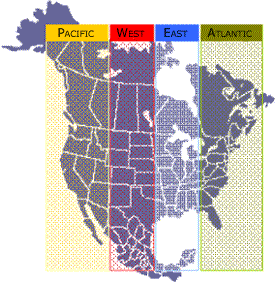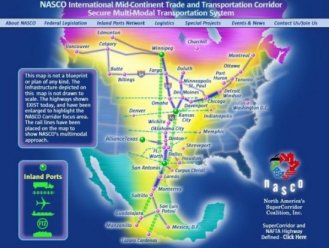From Dreams to Nightmares
"The IT Project That Ate America"
I realized after writing this
piece that the majority of people - including myself -
would start reading it and think..ugh! it's about
transportation legislation and the meaning of it.
Boring! And I wouldn't argue that - but the
subject itself - the information I was trying to convey -
proving it with quotes from the legislation - is that
transportation and transportation systems are integral to
the global conspiracy that is tearing this country apart and diminishing it's
prospects for the future. The NAFTA Superhighway is
only one piece of what is actually a global scale
Information Technology (IT) project that defines "central
planning". In the future, when historians look back,
they will say that this was the IT project that ate America
- bankrupting and defeating all that it stood for - for
nearly 400 years.
On any given problem - and obviously, this is a big one, the only way to solve the problem is to get to the source of the problem - otherwise, you're like a doctor treating the symptoms of a disease and not treating the disease itself. The Intermodal Surface Transportation Efficiency Act of 1991 (ISTEA) is the disease. The Trans-Texas Corridor aka NAFTA Superhighway is a symptom and if you can make yourself stay awake through this webpage - and connected webpages, I promise you'll come away with a better idea of what needs to be done about it.
I hadn't thought about that program in years until I started researching the NAFTA Superhighway. The NAFTA Superhighway is the implementation of one of the Big Dreams from the 1960's. The dream was an intelligent highway system with intelligent cars2 that would have collision detection and prevention systems; traffic flow control systems; your car would talk to you and tell you the best route to take and it would give you road conditions ahead. It was fantastic and just the prospect of it was exciting. But here we are in the 21st Century and we are facing the reality of the Big Dream becoming the Big Nightmare.
Intermodal Surface Transportation Efficiency
The shift in transportation policy away from just building highways and moving us towards the 21st Century Nightmare began with the Intermodal Surface Transportation Efficiency Act of 1991 (ISTEA). In that legislation, Congress declared the Dwight D. Eisenhower National System of Interstate and Defense Highways (Interstate System) complete and the 'National Highway System (NHS)' was created. The NHS included not only the Interstate System but also the feeder routes (urban and rural) leading to principal arterials and highways (including toll facilities), ports, airports, public transportation facilities, and other intermodal transportation facilities.
In the legislation, the purpose was described thusly:
`The purpose of the National Highway System is to provide an interconnected system of principal arterial routes which will serve major population centers, international border crossings, ports, airports, public transportation facilities, and other intermodal transportation facilities and other major travel destinations; meet national defense requirements; and serve interstate and interregional travel2
It doesn't seem out of line to consider that the ISTEA legislation federalized the entire U.S. system of roads because all roads feed into - or lead to one of the major hubs mentioned above - except perhaps for Alaska where they have a road to nowhere. Maybe that was an act of rebellion on the part of Alaskans.
The 1992, IVHS Strategic Plan produced by the Intelligent Highway Systems (IVHS) was requested by the DOT.
"DOT asked IVHS AMERICA to draw on its membership to develop a Strategic Plan for IVHS in the United States and set it in an international context. This document is that Strategic Plan. Written by the Strategic Planning Subcommittee of IVHS AMERICA, it can fairly be called a consensus of the IVHS community in the U.S."8
This group was essentially given carte blanch to redesign America's transportation and border infrastructure for the purpose of building world's first fully automated, advanced technology highways and facilities, managed by information and control systems.
IVHS is, in fact, a paradigm shift. The transportation/information infrastructure is a new way of looking at, thinking about, and improving mobility - a sociological as well as a technological revolution. The shift is ongoing in air and rail transportation. That paradigm shift is needed in highway and public transportation as well.9
And it was always planned as an international project even though there were no agreements in place for it except the Canadian FTA. In fact, one has to wonder if Dallas wasn't chosen for the initial project (Mobility 2000) because it was one of the principal international routes.
"Efforts already under way to create a North American IVHS program are consistent with recent developments toward increased economic cooperation between the U.S., Canada, and Mexico."10
North American Trade Corridors
(Source: North American Forum on Integration)
Section 1006 - ISTEA of 1991
(h) National Defense Highways Located Outside United States
-
(1) Reconstruction projects.-If the Secretary determines,
after consultation with the Secretary of Defense, that a
highway, or portion of a highway, located outside the United
States is important to the national defense, the Secretary
may carry out a project for the reconstruction of such
highway or portion of highway.
The National Highway System Designation Act of 1995 (P.L. 104-59) that was signed by President Clinton on November 28, 199512
SEC. 359. MISCELLANEOUS
STUDIES.
(a) <<NOTE: 23 USC 309 note.>>
Pan American Highway.--
(1) Study.--The Secretary shall conduct a study on the
adequacy of and the need for
improvements to the Pan
American Highway.
(2) Elements.--The study shall include, at a minimum, the
following elements:
(A) Findings on the
benefits of
constructing a highway at
Darien Gap, Panama and Colombia.
(B) Recommendations for a
self-financing arrangement
for completion and maintenance of the
Pan American
Highway.
(C) Recommendations for establishing
a Pan American
highway authority to monitor
financing, construction,
maintenance, and operations of the
Pan American Highway.
(D)
Findings on the
benefits to trade and prosperity of a
more efficient Pan American Highway.
(E) Findings on the
benefits to United
States industry
resulting from the use of United
States technology and
equipment in construction of
improvements to the Pan
American Highway.
xxxxxxxxxxxxxxxxxxxxxxxxxxxxxxxxxxxxxxxxxxxxxxxxxxxxxxxxxxxxxxxxxxxxxxxxxxxxx
x
SEC. 2. DECLARATION OF POLICY: INTERMODAL
SURFACE TRANSPORTATION
EFFICIENCY ACT.
It is the policy of the United States to develop a
National Intermodal Transportation System that is
economically efficient and environmentally sound,
provides the foundation for the Nation to compete
in the global economy, and will move people and
goods in an energy efficient manner.
The National Intermodal Transportation System
shall consist of all forms of transportation in a
unified, interconnected manner, including the
transportation systems of the future, to reduce
energy consumption and air pollution while
promoting economic development and supporting the
Nation's preeminent position in international
commerce.
The National Intermodal Transportation System
shall include a National Highway System which
consists of the National System of Interstate and
Defense Highways and those principal arterial
roads which are essential for interstate and
regional commerce and travel, national defense,
intermodal transfer facilities, and international
commerce and border crossings.
The National Intermodal Transportation System shall provide improved access to ports and airports, the Nation's link to world commerce.
The National Intermodal Transportation System shall be adapted to ``intelligent vehicles'', ``magnetic levitation systems'', and other new technologies wherever feasible and economical, with benefit cost estimates given special emphasis concerning safety considerations and techniques for cost allocation.
Mobility 2000
Mobility 2000 was the name of the Dallas-Fort Worth federally mandated, regional transportation study that was completed in 1986. Two years later, after a conference attended by various groups involved in road and traffic management, a national special interest group was formed. They named themselves Mobility 2000.3
"In 1988, Mobility 2000 was formed to develop a national program of automated highway technology, which eventually evolved into Intelligent Transportation systems (ITS). Mobility was the organizational precursor to ITS America, of which AASHTO [American Association of State Highway and Transportation Officials] was a founding member"4.
"Founded in 1988, Mobility 2000 was an informal assembly of industry, university, and government representatives created to promote the use of advanced technologies to improve highway safety and efficiency. The initiative was formalized in 1991, when the Intermodal Surface Transportation Efficiency Act (ISTEA) was enacted, and the national Intelligent Vehicle Highway System (IVHS) program was established. A growing sense soon developed in the IVHS community, especially in the public transit arena, that “intelligent vehicle highway systems” did not embrace all the transportation modes addressed in the national IVHS program. In 1994, the national IVHS program was renamed the Intelligent Transportation System (ITS), to clarify the multi-modal intent."5
"In 1991, the Intermodal Surface Transportation Efficiency Act (ISTEA) provided this initial funding and authorized the organization to be a Federal Advisory Committee to the U.S. Department of Transportation. Among its first major tasks was the development of a strategic plan for ITS deployment in the U.S. The document was a collaborative effort among the organization’s membership and the U.S. DOT set a national framework for guiding the development of intelligent transportation systems."6
* * * * *
"The mission of the IVHS community in the U.S. - composed of all levels of government; the automotive, electronic, communications, and information industries; and academia - is first, to improve surface transportation by deploying IVHS technology broadly throughout the nation and, in cooperation with Mexico and Canada, throughout North America, and second, to develop a U.S.-based IVHS industry to provide technology in the U.S. and abroad."7
North American
Super Corridor Coalition (NASCO)
Security and Prosperity Partnership

Section 1006 of the Intermodal Surface Transportation Efficiency Act of 1991 (Public Law 102-240) authorized the NHS. However, the act made clear that the NHS was not intended to be simply a highway system. Rather, it was intended to provide the links that would unite a national intermodal transportation network in a unified, interconnected manner.
In December 1993, the Department submitted its recommendations to Congress for designation of the NHS. The recommendations included some connections to intermodal terminals, but the Department's report noted that the proposals received from the State transportation departments were not sufficiently consistent to warrant final designation of all connectors. The 1995 act, which designated the NHS, directed the Department to submit, within 180 days of enactment, modifications to the NHS to provide connections "…to major ports, airports, international border crossings, public transportation and transit facilities, interstate bus terminals, and rail and other intermodal transportation facilities." These connections, which are eligible on an interim basis for NHS funding, are subject to approval by Congress.
This submission, developed wit the cooperation of the State transportation departments, metropolitan planning organizations, and terminal operators, identifies additional connections that should be part of the NHS. As discussed in the enclosed report, Pulling Together: The National Highway System and Its Connections to Major Intermodal Terminals, the recommended connections are consistent with criteria developed to address the earlier concern about consistency.
Both the letter and the report: Pulling Together: The National Highway System and Its Connections to Major Intermodal Terminals can be found on the Federal Highway Administration website. If for some reason, access to the report is not available, a pdf has been captured and may be accessed HERE.
"Spending authority for the ITS program grew from $20 million in 1991 to $227.5 million in 1995. For the 1991-1995 period, the Congress has voted $827.6 million, and by the end of fiscal year 1994 the Department of Transportation had obligated $544 million for the program (see Summary Table 1)." 11
So if the National Highway System isn't just highways, then what is it? Click HERE to continue
Click HERE for a pdf version of this article and connected pages (Part 1)
1) U.S. Dept of Transportation, Research
and Innovation Technology Administration (RITA), H.R. 2950 Intermodal Surface Transportation Efficiency Act of 1991
(ISTEA),
http://ntl.bts.gov/DOCS/istea.html
2) U.S. Dept of Transportation, Research and
Innovation Technology Administration (RITA), H.R. 2950 Intermodal Surface Transportation Efficiency Act of 1991
(ISTEA), National Highway System Replacement language for
Section 103 of Title 23 Section 1006 (a) (b) (1) Purpose
http://ntl.bts.gov/DOCS/istea.html
3) U.S. Dept of Transportation, Federal Highway
Administration, Lyle Saxton, "Mobility 2000 and the Roots of IVHS"
http://www.itsdocs.fhwa.dot.gov/JPODOCS/BRIEFING/9003.pdf
4) Siradol
Siridhara, Virginia Tech Digital Library, 'AHS Maglev System
Architecture', Dissertation, URN: etd-100799-120014,
8/23/1999,
http://scholar.lib.vt.edu/theses/available/etd-100799-120014/
section referenced: Introduction - Page 2,
http://scholar.lib.vt.edu/theses/available/etd-100799-120014/unrestricted/1introduction.PDF
5) I-70 Rural IVHS Corridor Master Plan, Colorado Dept of
Transportation, De Leuw, Cather & Company, April 1996,
660205-01450
Appendix C--ITS Acronyms
http://www.itsdocs.fhwa.dot.gov/edldocs/3825/app-c.pdf
(entire report)
http://www.itsdocs.fhwa.dot.gov/JPODOCS/REPTS_TE/3825.pdf
(very large pdf)
6) Intelligent Transportation Society of America (ITS
America) history, ITS America website
http://www.itsa.org/itsa_history/c48/Inside_ITSA/ITS_America_History.html
(Note: former name was Intelligent Vehicle Vehicle Highway
Society (IVHS))
7) Strategic Plan for Intelligent Vehicle Highway Systems in
the United States, IVHS America, Report No: IVHS-AMER-92-3,
May 20, 1992, Mission Statement, Page II-7 (pdf p.34)
http://www.itsdocs.fhwa.dot.gov/JPODOCS/REPTS_PR/1823.pdf
8) Strategic Plan for Intelligent Vehicle Highway Systems in
the United States, IVHS America, Report No: IVHS-AMER-92-3,
May 20, 1992, Page II-1 (pdf p.28)
http://www.itsdocs.fhwa.dot.gov/JPODOCS/REPTS_PR/1823.pdf
9) Strategic Plan for Intelligent Vehicle Highway Systems in
the United States, IVHS America, Report No: IVHS-AMER-92-3,
May 20, 1992, Page II-4 (pdf p.31)
http://www.itsdocs.fhwa.dot.gov/JPODOCS/REPTS_PR/1823.pdf
10) Strategic Plan for Intelligent Vehicle Highway Systems
in the United States, IVHS America, Report No:
IVHS-AMER-92-3, May 20, 1992, Page I-15 (pdf p.22)
http://www.itsdocs.fhwa.dot.gov/JPODOCS/REPTS_PR/1823.pdf
11) Congressional Budget Office,
High-Tech Highways: Intelligent Transportation Systems and
Policy, October 1995
http://www.cbo.gov/ftpdocs/0xx/doc16/Highways.pdf
Additional info on spending:
http://www.cbo.gov/publications/bysubject.cfm?cat=21
12) The National Highway System Designation Act of 1995
(P.L. 104-59) ,
http://frwebgate.access.gpo.gov/cgi-bin/getdoc.cgi?dbname=104_cong_public_laws&docid=f:publ59.104


